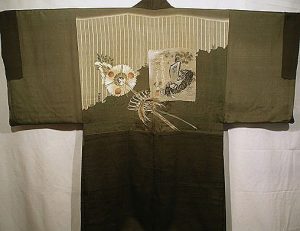ANTIQUE HAORI
The Japanese Haori (how-ree) is a formal overcoat. It is typically hand woven of solid black silk with the exception of 3, 4, or 5 white circles that contain a pictorial symbol of the family’s crest. The word “Haori” is a form of the Japanese verb meaning “to put on.” A Haori formalizes an outfit in much the same way that adding a jacket creates a proper suit. The upper classes were required to wear one by the strict dress codes of Japan during the time when a display of expensive decoration was to be avoided.
Because of this, the Haori adopted the most intriguing aspect of its design: the main source of decoration is on the inside of the back panel or lining. Thus, some of the most spectacular of the textile artworks created from the 16th through the 19th centuries were those intended for personal satisfaction.
The Haori was, therefore, very typically Japanese, as the outside world had no indication of the true status of the individual until he chose to remove his overcoat. Although these garments served a practical purpose, it was the art that adorned the interior of each piece that made the Haori a family heirloom. Each panel was commissioned by its owner as a unique work of art. The hand embroidery, hand painting (oftentimes signed by a famous artist), dyeing and weaving of the design made each a museum quality, treasured, rare, irreplaceable, and one of a kind artistic masterpiece.
***The Textile Art Collection will pack and ship for free within the continental US>
Showing 1–12 of 24 results












